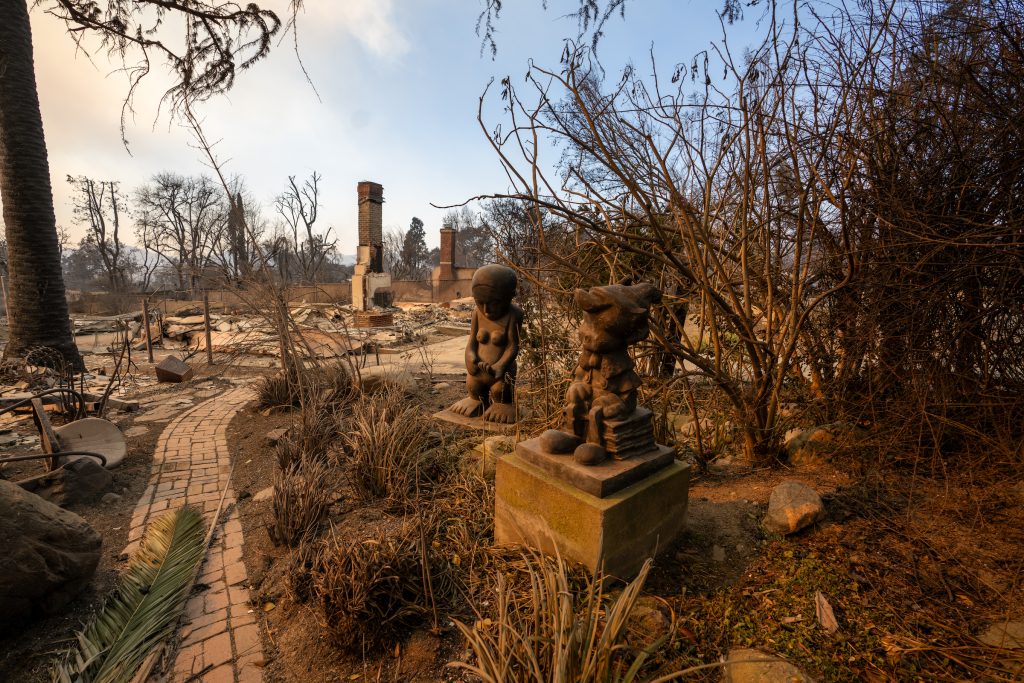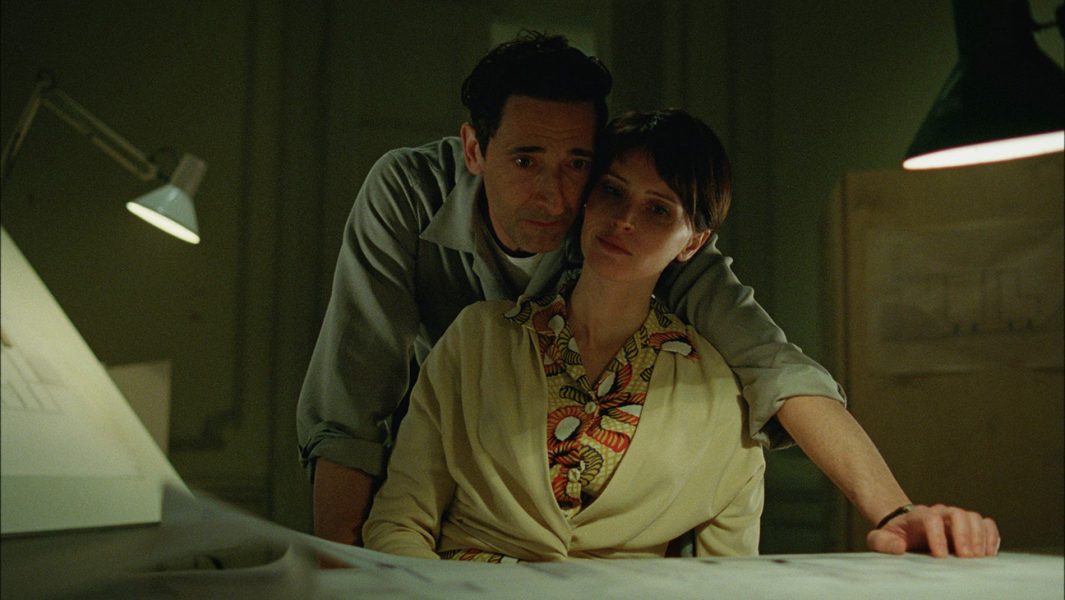The Unfathomable Loss of Artistic Heritage in Altadena – Hyperallergic

Hyperallergic
Sensitive to Art & its Discontents
Privacy Policy
Success! Your account was created and you’re signed in.Please visit My Account to verify and manage your account.An account was already registered with this email. Please check your inbox for an authentication link.We rely on readers like you to fund our journalism. If you value our coverage and want to support more of it, please join us as a member.LOS ANGELES — Among all the destruction brought on by the unprecedented wildfires still burning across parts of LA County, the overwhelming devastation in Altadena is almost unfathomable. Located 14 miles northwest of downtown, Altadena is a remarkably diverse, solidly middle-class community, one artists flocked to because of its affordability, ample space, and proximity to both nature and culture. With much of it now in ruins and decades’ worth of heritage burned — from Gary Indiana’s personal library to the sprawling Zorthian Ranch arts community to countless homes and structures — and no clear picture of recovery, artists are reflecting on the staggering loss and beginning to imagine what the future might look like.Artist Paul McCarthy and his family bought a piece of land and moved there in 1989, putting his skills as a construction worker to use. “Their dream was to build a house, and Altadena was the place they could do that,” his daughter, the gallerist Mara McCarthy, told Hyperallergic. “They built it from the ground up.” Mara moved back to Altadena from New York in 2007, looking for “a place where I could have the possibility of something,” and bought a house nearby. Her brother Damon lived in the area as well. Now all three houses are gone. She said her mother is eager to start drawing up plans for a new house, but for her, “right now, it’s just about survival.”Get the latest art news, reviews and opinions from Hyperallergic.Altadena is notably diverse, with a thriving Black community. Roughly four out of five Black residents own their own homes, double the national rate. This is especially true west of Lake Avenue in West Altadena, one of the only areas in the region where Black individuals could buy homes before racist redlining policies were outlawed in the 1960s. That’s where artist Kenturah Davis grew up, and where several members of her mother’s family moved in the 1970s. “It was a mass migration from Arkansas,” Davis told Hyperallergic. “We had a joke that we couldn’t date anyone from Altadena because we might be related to them.”After relocating several years ago, Davis decided to return to Altadena when she was pregnant with her now two-year-old son. “I was thinking about the kind of life I wanted for him, and recalling how wonderful it was to grow up there, to be close to nature with access to the rest of LA,” Davis said.She moved back in 2022, buying a home that she later realized shared a fence with her family’s first house in Altadena. Both of those buildings are now gone, along with her parents’ residence nearby, where they had lived for 40 years, and her aunt’s house.“I’m drifting between grief and gratitude,” Davis said, “overwhelmed with all the resources that have surfaced.” Although she is still dealing with the immediate aftermath of the tragedy, she said she hopes to rebuild there.“The character of Altadena is so special, I don’t want that to change,” she said. “I would hate for so many people to get replaced by developer greed. It has a real hometown feel. I feel somewhat responsible for keeping that aspect alive.” Diversity was part of what drew Joy Silverman, a longtime arts worker and former executive director of Los Angeles Contemporary Exhibitions (LACE), to Altadena. She purchased a mid-century house there in 1999 with her husband, psychologist and professor George Bermudez, and their young daughter Sula Bermudez-Silverman, now an artist. On Tuesday evening, January 7, they were spending the night at Sula’s house for her birthday. Since they had only received a fire warning, not an evacuation order, they packed just three artworks: a leaf with a silhouette inscribed on it gifted by Ana Mendieta, a gourd onto which Lari Pittman had painted the word “hope,” and an artwork by her daughter, fully expecting to return. They were awoken by an evacuation alert at 3am, and when Bermudez drove back to their house, it was engulfed in flames. “We’ve lost everything,” he told Silverman over the phone.“We had such a rich community in so many ways, the history is amazing,” Silverman said. “It had diversity, artists, architects, scientists, rich people, poor people, and it was normal. We loved it.”Writer and artist Ross Simonini, who moved to Altadena in 2020, fondly described the area’s heterogeneous milieu, which he views as quintessentially Angeleno.“It has the kind of art history that is very LA, an eccentric mixed bag, all types of economic, esoteric, and professional sensibilities — it’s all there,” Simonini said, speaking from Northern California where he, his wife, and their three-month-old baby had evacuated. He lost his home and studio, where he would also organize exhibitions and performances under the moniker Alicia Zone.Painter John Knuth moved his family to Altadena a decade ago, buying a home on a quiet street where cars shared the road with kids on bicycles and horseback riders. Although he recently moved into a studio that survived, he lost 25 years of personal archives and artwork in the blaze, as well as materials from Circus Gallery and Ambach & Rice gallery, where he once worked as director.A few houses survived on his block, but one street over, “it’s like Dresden, just chimneys and dead trees,” he said. “We wanted to live the rest of our lives in that house and now I don’t know what our future looks like.”The gallery Alto Beta, located in a strip mall between a pizza restaurant and the performance venue Public Displays of Altadena, was completely destroyed, owner Brad Eberhard told Hyperallergic. Among the losses were paintings by Mary Anna Pomonis, whose exhibition had just opened at the gallery, as well as much of Eberhard’s own artwork, his art book library, and “every record I’ve collected since I was 12,” he said, adding: “I lost my spiritual center.” Many have found one silver lining amid the catastrophe: a heightened sense of community and kinship. Ruth Gallery in Pasadena has offered to house Alto Beta’s next two shows, beginning with an exhibition of meticulous abstract drawings by Brian Randolph opening on February 9. “I’ve never experienced so much appreciation in my life,” Eberhard said. “The art community has never seemed like such a real thing for me as now.” Also lost to the fires was the Zorthian Ranch, a 45-acre creative community located at the base of the San Gabriel Mountains. It was founded by the late artist and craftsman Jirayr Zorthian, who was a boy when his family fled the Armenian Genocide, emigrating to the United States in 1922. They settled in New Haven, Connecticut, where he later studied art at Yale University. In the late 1940s, Zorthian and his first wife purchased land in the Altadena foothills, slowly building structures on the property from whatever he could scavenge.“He spent his entire life creating this palace of discarded materials,” his granddaughter Tara Zorthian told Hyperallergic. “Besides the main house and the pool, everything else he built out of stuff people were throwing away.”Although he was an accomplished artist, creating several murals for the Works Progress Administration, Zorthian existed on the fringes of the mainstream art world. “He didn’t want to play the art game,” Tara explained. The ranch became an alternative hub of art and culture, welcoming everyone from Charlie Parker to Andy Warhol to physicist Richard Feynman.Zorthian died in 2004 at the age of 92, passing the property on to some of his children. Tara, her cousins Caroline and Julia, and other family members have spent much of the past decade cleaning up the ranch, hosting community events, tours, and exhibitions, and sorting through and organizing Zorthian’s massive archive that included a lifetime of artwork, family photos, films, and letters.“The archive was such a big culmination of effort. No one had really gone through it,” Caroline told Hyperallergic. “It was a labor of love.”As the Eaton Fire approached last Tuesday evening, they relocated most of the animals on the ranch — goats, horses, sheep, pigs, and cows — to sanctuaries or opened their pens so they could escape. They tried to spray down buildings with water but were finally forced to evacuate around 3am. “There’s never been a fire that’s headed towards us so quickly,” Caroline said. A couple of structures survived, but the archives and art, housed in storage containers and in the cellar below the main house, were all lost. “I have no idea what happens next,” she said. “Maybe this will be a new blank page.”We hope you enjoyed this article! Before you keep reading, please consider supporting Hyperallergic’s journalism during a time when independent, critical reporting is increasingly scarce.Unlike many in the art world, we are not beholden to large corporations or billionaires. Our journalism is funded by readers like you, ensuring integrity and independence in our coverage. We strive to offer trustworthy perspectives on everything from art history to contemporary art. We spotlight artist-led social movements, uncover overlooked stories, and challenge established norms to make art more inclusive and accessible. With your support, we can continue to provide global coverage without the elitism often found in art journalism.If you can, please join us as a member today. Millions rely on Hyperallergic for free, reliable information. By becoming a member, you help keep our journalism free, independent, and accessible to all. Thank you for reading.
Matt Stromberg is a freelance visual arts writer based in Los Angeles. In addition to Hyperallergic, he has contributed to the Los Angeles Times, CARLA, Apollo, ARTNews, and other publications.
More by Matt Stromberg
You must be a Member to post a comment. Sign in or become a member now.
This week: subway art honors NYC’s Native history, García Márquez on Netflix, Rachmaninoff’s last student turns 100, test-driving IKEA rooms, and much more.The visionary film director and artist was an institution unto himself — primarily of cinema, but also painting, music, photography, and culture at large. Notre Dame is accepting graduate applications for fall 2025 in Studio Art (Painting/Drawing, Photography, Ceramics, Sculpture) and Design (Industrial Design, Visual Communication Design).Though not forbidden by nonprofit guidelines, such events at museums and institutions have long generated controversy.The celebratory and regenerative bells of Davina Semo and Ashwini Bhat, Kota Ezawa’s Alcatraz-inspired “video mural,” and more. Despite the fact that most of humanity has shared the devastating emotional turmoil of a breakup, the topic is strangely elusive in the history of art. Rather than trying to fool us with her representational paintings or showing off her virtuosity in the realm of resemblance, everything is on the surface.Johnson’s latest explorations into color, perception, familiarity, and scale are now on view at Flea Street in Menlo Park, California.“After teaching middle school for years, quiet still feels like a rare and precious luxury. Many ideas come to me amidst this silence.” Donors include the Helen Frankenthaler and Ford foundations, the Getty and LACMA, and commercial galleries. Hyperallergic is a forum for serious, playful, and radical thinking about art in the world today. Founded in 2009, Hyperallergic is headquartered in Brooklyn, New York.
Enter the code sent to your email.
Email address
Enter your password
Sign in by entering the code we sent to , or clicking the magic link in the email.
Privacy Policy. This site is protected by reCAPTCHA and the Google Privacy Policy and Terms of Service apply.
Get the best of Hyperallergic directly in your email inbox.
Sending to:
Source: http://hyperallergic.com/983707/the-unfathomable-loss-of-artistic-heritage-in-altadena/





